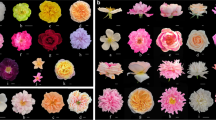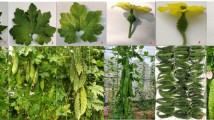Abstract
The extent of genetic diversity among 21 Jatropha curcas individuals originating from eight different countries (Cape Verde, India, Indonesia, Malaysia, Philippines, South Africa, Thailand, and Vietnam) was estimated using 41 simple sequence repeat (SSR) markers. The markers used include 29 previously reported SSR markers and 12 in-house developed SSR markers (by exploiting nucleotide sequences retrieved from public databases). All microsatellite markers were monomorphic, indicating the lack of genetic diversity among the individuals analyzed in the study. Though the seed sources were collected from eight different countries belonging to two different continents, this homogenous nature of J. curcas individuals revealed in SSR analysis was quite surprising. As J. curcas is a widely targeted industrial oil crop, this report warns the existence of narrow genetic base and limitation of SSR-based marker-assisted selection for further breeding and genetic improvement of these individuals.

Similar content being viewed by others
References
Achten WMJ, Nielsen LR, Aerts R, Lengkeek AG, Kjar ED, Trabucco A, Hansen JK, Maes H, Graudal L, Akinnifeil FK, Muys R (2010) Towards domestication of Jatropha curcas. Adv Biochem Eng Biotechnol 1:91–107
Alves AA, Bhering LL, Rosado TB, Laviola BG, Formighieri EF, Cruz CD (2013) Joint analysis of phenotypic and molecular diversity provides new insights on the genetic variability of the Brazilian physic nut germplasm bank. Genet Mol Biol 36:371–381
Arolu IW, Rafii MY, Hanafi MM, Mahmud TMM, Latif MA (2012) Molecular characterization of Jatropha curcas germplasm using inter simple sequence repeat (ISSR) markers in Peninsular Malaysia. Aust J Crop Sci 6:1666–1673
Basha SD, Sujatha M (2007) Inter and intra-population variability of Jatropha curcas (L.) characterized by RAPD and ISSR markers and development of population-specific SCAR markers. Euphytica 156:375–386
Basha SD, Francis G, Makkar HPS, Becker K, Sujatha M (2009) A comparative study of biochemical traits and molecular markers for assessment of genetic relationships between Jatropha curcas L. germplasm from different countries. Plant Sci 176:812–823
Benbouza H, Jacquemin JM, Baudoin Y, Mergeai G (2006) Optimization of a reliable, fast, cheap and sensitive silver staining method to detect SSR markers in polyacrylamide gels. Biotechnol Agron Soc Environ 10:77–81
Bressan EA, Scotton DC, Ferreira RR, Jorge EC, Sebbenn AM, Gerald LTS (2012) Development of microsatellite primers of Jatropha curcas (Euphorbiaceae) and transferability to congeners. Amer J Bot 99:237–239
Bressan EA, Sebbenn AM, Ferreira RR, Lee TSG, Figueira A (2013) Jatropha curcas L. (Euphorbiaceae) exhibits a mixed mating system, high correlated mating and apomixis. Tree Genet Genomes 9:1089–1097
Dehgan B, Webster GL (1979) Morphology and infrageneric relationships of the genus Jatropha (Euphorbiaceae). Univ Calif Publ Bot 74:1–72
Divakara BN, Upadhyaya HD, Wani SP, Gowda CL (2010) Biology and genetic improvement of Jatropha curcas L.: a review. Appl Energy 87:732–742
Fairless D (2007) Biofuel: the little shrub that could maybe. Nature 449:652–655
Gupta P, Idris A, Mantri S, Asif MH, Yadav HK, Roy JK, Tuli R, Mohanty CS, Sawant SV (2012) Discovery and use of single nucleotide polymorphic (SNP) markers in Jatropha curcas L. Mol Breed 30:1325–1335
Heller J (1996) Physic nut-Jatropha curcas L. Promoting the conservation and use of underutilized and neglected crops. International Plant Genetic Resources Institute, Rome, Italy. Available from: http://www.bioversityinternational.org/nc/publications/publication/issue/physic_nut_emjatropha_curcasem_l.html
Islam AKMA (2011) Improvement of biodiesel production through genetic studies of Jatropha curcas. Ph D Thesis, Department of chemical and process engineering, Universiti Kebangsaan Malaysia, Bangi 43600, p 254
Kumari A, Mahapatra P, Garlapti VK, Banerjee R (2009) Enzymatic transesterification of Jatropha oil. Biotechnol Biofuels 2:1
Machua J, Muturi G, Omondi SF, Gicheru J (2011) Genetic diversity of Jatropha curcas L. populations in Kenya using RAPD molecular markers : implication to plantation establishment. Afr J Biotechnol 10:3062–3069
Masoudi-Nejad A, Tonomura K, Kawashima S, Moriya Y, Suzuki M, Itoh M, Kanehisa M, Endo T, Goto S (2006) EGassembler: online bioinformatics service for large-scale processing, clustering and assembling ESTs and genomic DNA fragments. Nucleic Acids Res 34:W459–W462
Maurya R, Gupta A, Singh SK, Rai KM, Sawant SV, Yadav HK (2013) Microsatellite polymorphism in Jatropha curcas L.—a biodiesel plant. Ind Crop Prod 49:136–142
Nicot N, Chiquet V, Gandon B, Amilhat L, Legeai F, Leroy P, Bernard M, Sourdille P (2004) Study of simple sequence repeat (SSR) markers from wheat expressed sequence tags (ESTs). Theor Appl Genet 109:800–805
Ouattara B, Ndir KN, Gueye MC, Diédhiou I, Barnaud A, Fonceka D, Cissé N, Akpo EL, Diouf D (2014) Genetic diversity of Jatropha curcas L. in Senegal compared with exotic accessions based on microsatellite markers. Genet Resour Crop Evol 61:1039–1045
Ovando-Medina I, Espinosa-García FJ, Núñez-Farfán JS, Salvador- Figueroa M (2011) State of the art of genetic diversity research in Jatropha curcas. Sci Res Essays 6:1709–1719
Parawira W (2010) Biodiesel production from Jatropha curcas: a review. Sci Res Essays 5:1796–1808
Phumichai C, Phumichai T, Kongsiri N, Wongkaew A, Sripichit P, Kaveeta R (2011) Isolation of 55 microsatellite markers for Jatropha curcas and its closely related species. Biol Plant 55:387–390
Popluechai S, Breviario D, Mulpuri S, Makkar HPS, Raorane M, Reddy AR, Palchetti E, Gatehouse AMR, Syers JK, O’Donnell AG, Kohli A (2009) Narrow genetic and apparent phenetic diversity in Jatropha curcas: initial success with generating low phorbol ester interspecific hybrids. Nat Proc hdl:10101/npre.2009.2782.1
Rafii MY, Shabanimofrad M, Puteri Edaroyati MW, Latif MA (2012) Analysis of the genetic diversity of physic nut, Jatropha curcas L. accessions using RAPD markers. Mol Biol Rep 39:6505–6511
Ram SG, Parthiban KT, Senthil Kumar R, Thiruvengadam V, Paramathma M (2008) Genetic diversity among Jatropha species as revealed by RAPD markers. Genet Resour Crop Evol 55:803–809
Ranade SA, Srivastava AP, Rana TS, Srivastava J, Tuli R (2008) Easy assessment of diversity in Jatropha curcas L. plants using two single-primer amplification reaction (SPAR) methods. Biomass Bioenerg 32:533–540
Rosado TB, Laviola BG, Faria DA, Pappas MR, Bhering LL, Quirini B, Grattapaglia D (2010) Molecular markers reveal limited genetic diversity in a large germplasm collection of a biofuel crop Jatropha curcas L. in Brazil. Crop Sci 50:2372–2382
Rozen A, Skaletsky HJ (2000) Primer3 on the WWW for general users and for biologist programmers. In: Krawetz S, Misener S (eds) Bioinformatics methods and protocols: methods in molecular biology. Humana, Totowa, pp 365–386
Santos CAF, Drumond MA, Rodrigues MA, Evangelista MRV (2010) Genetic similarity of Jatropha curcas L accessions based on AFLP markers. Crop Breed Appl Biotech 10:364–369
Subramanyam K, Muralidhararao D, Devanna N (2010) Genetic diversity assessment of wild and cultivated varieties of Jatropha curcas (L) in India by RAPD analysis. Afr J Biotechnol 8:1900–1910
Sudheer PDVN, Rahman H, Pamidimarri DVNS, Mastan SG, Reddy MP, Singh S (2010) Isolation of novel microsatellites using FIASCO by dual probe enrichment from Jatropha curcas L. and study on genetic equilibrium and diversity of Indian population revealed by isolated microsatellites. Mol Biol Rep 37:3785–3793
Sun Q, Li L, Li Y, Wu G, Ge X (2008) SSR and AFLP markers reveal low genetic diversity in the biofuel plant Jatropha curcas in China. Crop Sci 48:1865–1871
Tatikonda L, Wani SP, Kannan S, Beerelli N, Sreedevi TK, Hoisington DA, Devi P, Varshney RK (2009) AFLP-based molecular characterization of an elite germplasm collection of Jatropha curcas L., a biofuel plant. Plant Sci 176:505–513
Thiel T, Michalek W, Varshney RK, Graner A (2003) Exploiting EST databases for the development and characterization of gene-derived SSR-markers in barley (Hordeum vulgare L.). Theor Appl Genet 106:411–422
Vischi M, Raranciuc S, Baldini M, Agrarie S, Udine U (2013) Evaluation of genetic diversity between toxic and non toxic Jatropha curcas L. accessions using a set of simple sequence repeat (SSR) markers. Afr J Biotechnol 12:265–274
Wang CM, Liu P, Yi C, Gu K, Sun F, Li L, Lo LC, Liu X, Feng F, Lin G, Cao S, Hong Y, Yin Z, Yue GH (2011) A first generation microsatellite- and SNP-based linkage map of Jatropha. PLoS ONE 6:e23632
Wen M, Wang H, Xia Z, Zou M, Lu C, Wang W (2010) Development of EST-SSR and genomic-SSR markers to assess genetic diversity in Jatropha curcas L. BMC Res Notes 3:42
Yi C, Zhang S, Liu X, Bui HTN, Hong Y (2010) Does epigenetic polymorphism contribute to phenotypic variances in Jatropha curcas L.? BMC Plant Biol 10:259
Yue GH, Lo LC, Sun F, Cao SY, Yi CX, Hong Y, Sun WB (2013) No variation at 29 microsatellites in the genome of Jatropha curcas. J Genomics 2:59–63
Zane L, Bargelloni L, Patarnello T (2002) Strategies for microsatellite isolation: a review. Mol Ecol 11:1–16
Zhang Z, Guo X, Liu B, Tang L, Chen F (2011) Genetic diversity and genetic relationship of Jatropha curcas between China and Southeast Asian revealed by amplified fragment length polymorphisms. Afr J Biotechnol 10:2825–2832
Acknowledgments
This work was supported by the University Kebangsaan Malaysia (UKM) under Grant (AP-2012-008).
Author information
Authors and Affiliations
Corresponding author
Rights and permissions
About this article
Cite this article
Siju, S., Ismanizan, I. & Wickneswari, R. Genetic homogeneity in Jatropha curcas L. individuals as revealed by microsatellite markers: implication to breeding strategies. Braz. J. Bot 39, 861–868 (2016). https://doi.org/10.1007/s40415-014-0117-7
Received:
Accepted:
Published:
Issue Date:
DOI: https://doi.org/10.1007/s40415-014-0117-7




